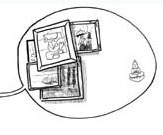
School News
The Diversity Disparity:
Report Examines Racial Diversity at SAIC
By Maureen Murphy
 |  "Diversity?" was the response of Nick Herrera, an undergrad with an emphasis in painting,
when asked what he thought of diversity at SAIC. Such a sarcastic remark, while not hoped for,
is in fact warranted as a school self-study report revealed.
The Office of Multicultural Affairs (OMA) recently released a Diversity Self-Study Report
(DSSR) that reveals that when it comes to racial diversity, SAIC leaves much to be desired.
Verlena Johnson, OMA program coordinator (also a recent SAIC grad) highlighted some of the
glaring problems: " ... the report indicates ... the decline in [African] American and Latino
students, and the fact that there aren't any institutional strategies implemented at the
departmental level that deal with faculty recruitment that work towards diversity."
Not only is the lack of diversity present among students, faculty, and administrators, but
studio class offerings are largely geared towards the Western aesthetic. According to the
DSSR, among the fall 2000 course offerings, of the 262 studio classes only five directly
address non-European art issues (such as Oriental Watercolor and Shibori Tie-Dye). |
|
Illustration by Alefandro Ayala
|
However, it would be inaccurate to conclude that SAIC offered no significant non-Eurocentric
classes. In the Art History department there are many classes, such as "Art and Architecture
of India," "Zen and the Arts," and "Latin American Avant-Gardes," that break away from the
European academic teachings of art. The Liberal Arts department can also serve as a model for
studio arts departments. "Fiction by Hispanic Women," "History of Jazz," "The African Diaspora,"
and "Introduction to Asian Philosophies" are just a small sampling of the plentiful classes
dealing with traditionally Eastern, African, and American minority themes.
But because not all degree programs require enrollment in at least one of these multicultural
classes, it is difficult to gauge how many students are exposed to non-Eurocentric ideas
towards art.
The lack of multiculturalism in the school's studio curriculum reflects that of the student
body. The number of students in the undergrad and graduate programs in fall 2000 combined
totaled 2,204. Of these, 67.1 percent are Caucasian. This number is slightly down from 1996,
when 71.2 percent of degree-seeking students were Caucasian. While the percentage of non-resident
aliens has is up from 9.6 percent in 1996 to 13.7 percent, the percentage of African-American and
Hispanic students has dropped.
When asked what minority outreach programs have been implemented by the Admissions Office in
the past, Kendra Dane, executive director of admissions and marketing, commented: "Our staff
have hosted Portfolio Preparation workshops in high schools as well as in cooperation with
programs such as Gallery 37 and the Marwen Foundation in Chicago. Members of our recruitment
staff are often asked to participate in such workshops throughout the nation as well as
participate as panelists in high school and community college arts festivals. We have also
worked with the Institute of American Indian Arts for several years to provide scholarship
assistance to deserving students who complete their first two years at IAIA and apply to SAIC."
Even less racially diverse than the student body is the 108 full-time faculty at SAIC. The
DSSR found that there were 92 white full-time professors, associate professors, and assistant
professors. In contrast, there was only one professor, and seven associate and assistant African
American professors. Four full-time faculty members were Asian/Pacific Islanders and four were
Latino. SAIC does not collect racial data for its part-time faculty. (*Numbers reflect 2000-2001
school year.)
According to the DSSR, the lack of a diverse faculty presents a problem for
the curriculum.
"With such a low number of faculty members of color, many find that they are the only voice
within a department to represent their interests. Some departments have no representative at all.
Consequently, curriculum development occurs without full consideration of what new pedagogies,
theories, approaches, and content can contribute to a course of study. Faculty of color must rely
on the good intentions of faculty who do not always have expertise in non-Western or non-traditional
subjects."
Just as prospective minority students might take issue with the lack of diverse studio classes,
prospective minority faculty might conclude from what the DSSR describes as "[the] scant evidence
of a critical mass a faculty of color actively engaged in the primary concerns of tenure track
faculty (e.g., teaching, developing curriculum, serving on committees, researching their primary
areas of interests), [that] they are not encouraged to seriously consider a position at SAIC."
The DSSR acknowledges that SAIC's affirmative action policy is limited to the statement: "As
indication of our commitment to our affirmative action, [SAIC's] policy of non-discrimination
is prevalent throughout every aspect of our relationship with faculty, including recruitment
advertisement, recruitment, selection, compensation, promotion, tenure, [and] enrichment."
Since the Assistant Dean of Minority and Multicultural Affairs left in 1995, the school has
lacked a full-time affirmative action faculty member to develop programs to attract more minority
applicants and create guidelines for the interview process. The DSSR points out " ... faculty of
color who are strong candidates may not receive consideration because they do not fit the stereotype
the committee holds of African-American, Asian, Latino artists and academic[s]. In other words,
they are not ethnic or political enough."
This homogenization of minorities in the interview process resembles the presupposition that
students face in critiques: minority artists should create racially or politically charged work
dealing with their history or geography.
Student Government Co-President Ethan Roeder stated that dialogues have been initiated regarding
this problem.
"From my place in Student Government I see a really strong foundation of minority representation
in student groups and a lot of heightening awareness at SAIC about issues of diversity. The OMA
Crits ... bring issues of diversity to bear directly on artmaking practice here at the school,"
Roeder said.
Until a plan is developed that addresses the problem of diversity collectively - that is without
parting the faculty from the curriculum from the student body - the two central points of the
DSSR's conclusion will remain true: "Little commitment from the administration to actively cultivate
an inclusive environment and few members of traditionally underrepresented groups are present."
But the DSSR is evidence to Kendra Coleman, Director of the Office of Multicultural Affairs, that
SAIC is open to discussions about the problem of diversity. "There is no institutional strategy
[regarding diversity], but there are definitely people concerned with talking about it," Coleman
said.
|

